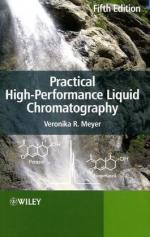|
This section contains 1,359 words (approx. 5 pages at 300 words per page) |

|
Chromatography is a technique used in analytical chemistry to separate and identify components of mixtures. The name comes from the Greek term for "color writing" because this method was originally used to separate colored samples. Today a variety of chromatography methods work by separating the individual components of mixtures so that each one can be analyzed and identified. Instruments used to perform chromatography are known as chromatographs, which have become essential pieces of equipment in chemical laboratories. With these devices, scientists can tell what chemical compounds are present in complex mixtures such as smog, cigarette smoke, petroleum products, or even coffee aroma.
The first chromatograph was invented just after the turn of the twentieth century by Russian botanist Mikhail Semenovich Tsvett (1872-1919), whose name (sometimes rendered as "Tswett") coincidentally means "color" in Russian. Tsvett was born in Italy of a Russian father and Italian mother. After studying in...
|
This section contains 1,359 words (approx. 5 pages at 300 words per page) |

|


